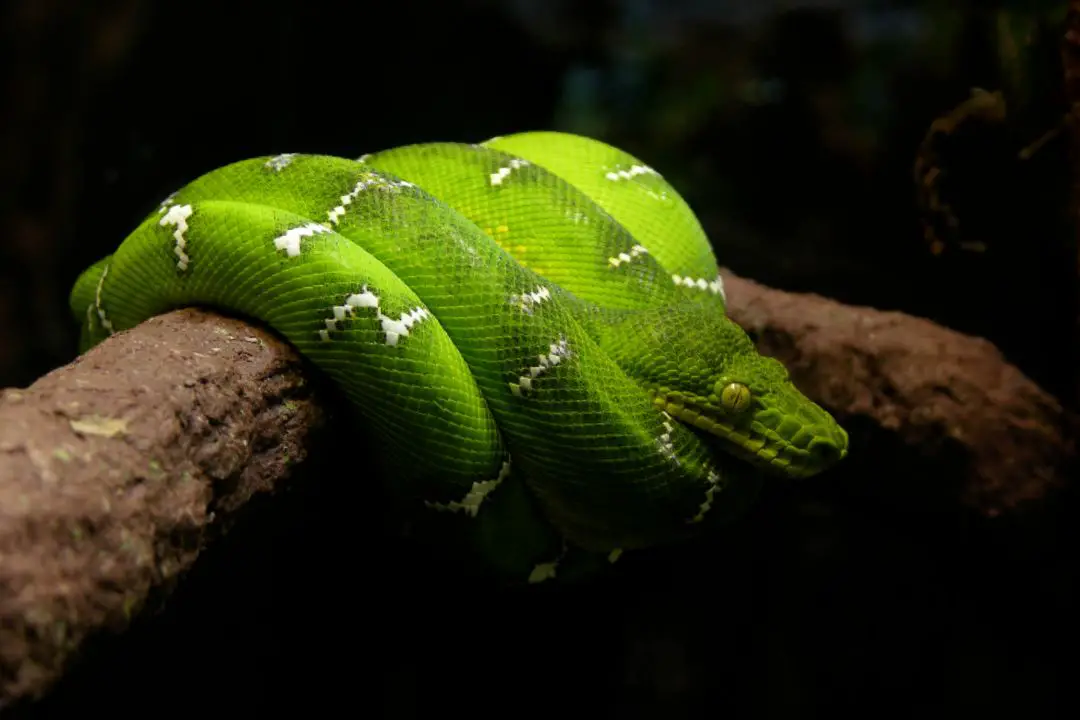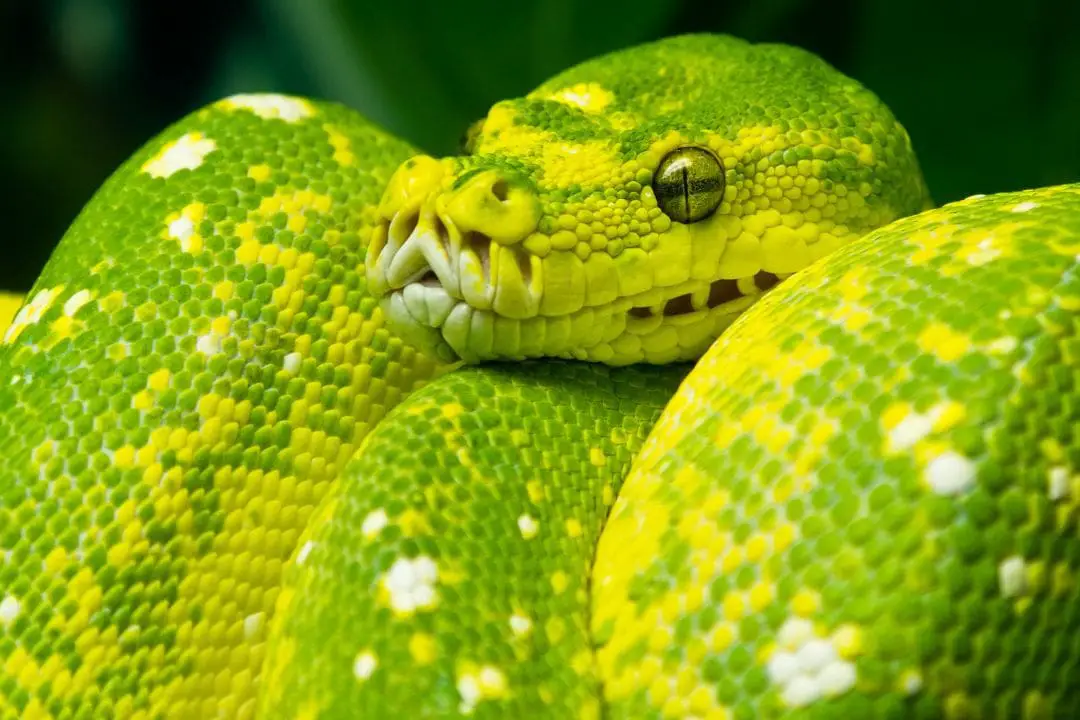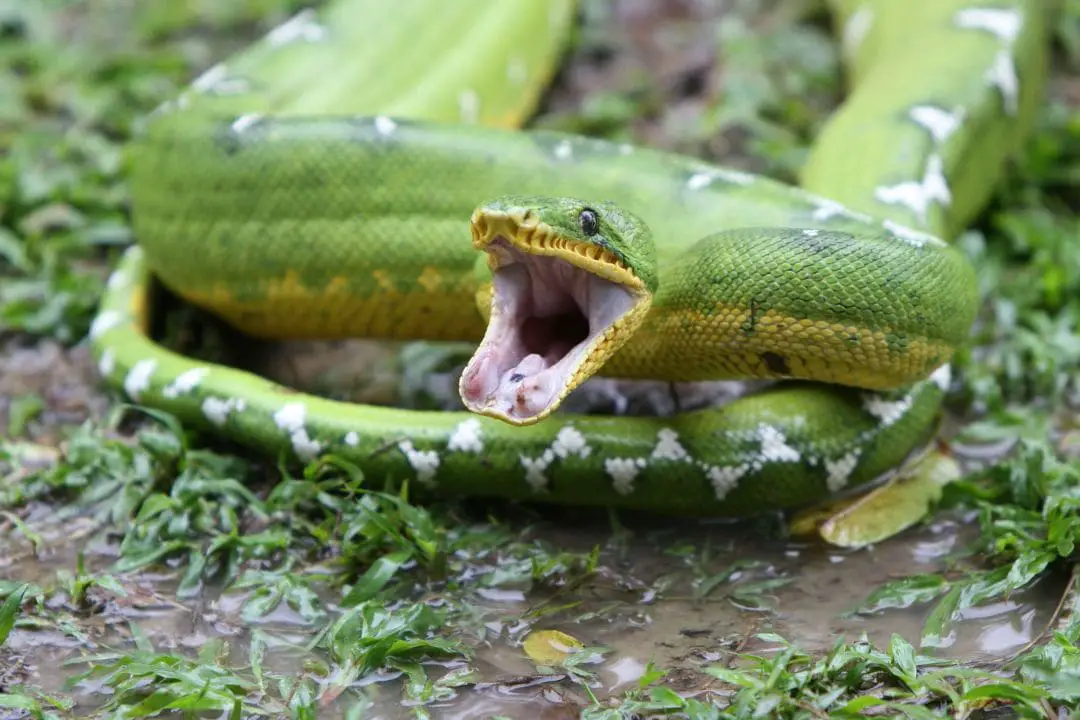Emerald tree boas are vivid, beautiful non-venomous snakes that spend nearly their entire lives in trees. They settle over a branch and simply wait for their prey to sneak by them, constrict it, and enjoy their dinner.
Emerald tree boas, or Corallus caninus, are very popular in the pet trade but are generally considered to be an intermediate to advanced display animal for keepers who have had other species in the past.
Why? Let’s take a look.
- Housing
- Regular Enclosure Maintenance
- Feeding
- Shedding
- Hibernation (Brumation)
- Handling
- Breeding
- Common Issues
- Frequently Asked Questions
- Are Emerald Tree Boas Good Pets?
- What Do Emerald Tree Boas Eat?
- Are Emerald Tree Boas Venomous?
- Where Does The Emerald Tree Boa Live In The Wild?
- Can You Handle an Emerald Tree Boa?
- Are Emerald Tree Boas Good For Beginners?
- Can Emerald Tree Boas Swim?
- Do Emerald Tree Boas Bite?
- Are Emerald Tree Boas Aggressive?
- Conclusion
- Sources
Housing
Finding the perfect place to keep an emerald tree boa is far more difficult than simply grabbing a 10 or 20 gallon aquarium from your local pet store and placing a fake bamboo branch with a couple of sticky cups on either side in there for the snake to rest on.
Emerald Tree Boa Enclosure
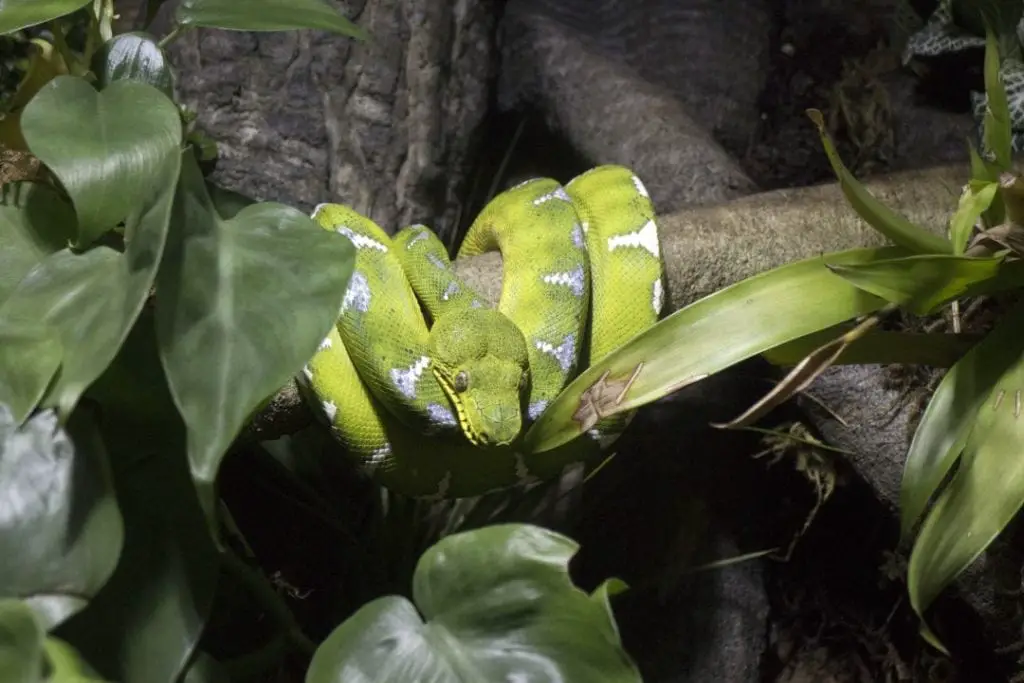
Juvenile emerald tree boas don’t need a tremendous amount of space, but adult snakes need some of the largest ExoTerras (or ExoTerra-like enclosures) frequently found on the market.
If you’re an intermediate keeper, we strongly recommend that you begin with an adult emerald tree boa that has a known ability to eat frozen/thawed prey, since juveniles can be picky.
However, if you do decide to begin with a juvenile Emerald Tree Boa, I recommend a 18X18x24 inches enclosure much like this:
REPTI ZOO 18″ x 18″ x 24″ Front Opening Terrarium
- Tough screen top provides ventilation and allows uvb and infrared penetration
- Raised, waterproof bottom frame in order to fit a substrate heater or a bioactive substrate
- Front-opening doors make you feed your pet easily and prevent escape
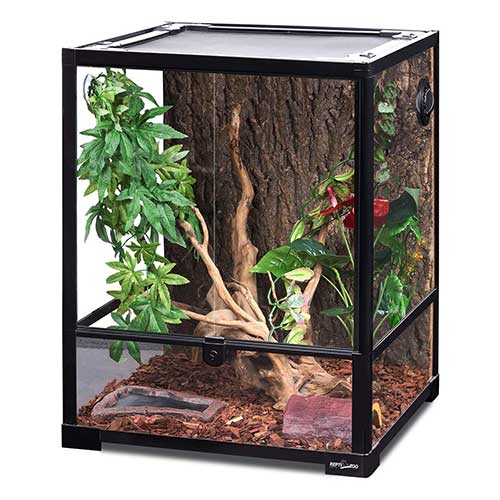
Though this arboreal snakes species requires relatively high humidity, the ventilation on the sides and top allow you to partially cover, fully cover, or fully leave open this screening to keep your snake in the correct humidity level no matter how your house’s humidity is currently reacting to weather outside.
Front access allows you to reach into any area of the display enclosure without alarming the snake and getting a really big bite. More on that soon.
For adults Emerald Tree Boas, a 36X18X36 inches enclosure is recommended.
You’ll want to give your snake plenty of room to zip sideways since these arboreal snakes also move throughout their native forests in a horizontal fashion.
Without horizontal space, there is a chance that your snake might strike into the glass of their own enclosure and either hurt itself, hurt you, or break the enclosure.
The Bigger the Better
That said, I prefer to see emerald tree boas in large cases of several feet wide if at all possible.
I realize that most hobbyists cannot afford thousands for one animal, but if you offer more space, emerald tree boas will appreciate it and seem to be a bit more docile; whether you see them using it or not.
And please remember not to house more than one emerald tree boa at a time within the cages linked above.
Though these are comfortable for one Emerald Tree Boa, I can’t recommend keeping a breeding pair in these.
I wouldn’t recommend a wooden vivarium for emerald boas due to the high humidity requirements, most tend to develop mold issues.
Substrate
Generally speaking, besides paper towel recommended for quarantine and juveniles you’re looking for a jungle-style blend.
Zilla’s Jungle Blend works well to keep humidity in and is relatively correct for the species per their natural habitat.
The ever-popular coconut coir Eco Earth is also a wonderful choice.
Your biggest decision here is if you prefer to buy your products in the store, put something together yourself, or create a living vivarium for your emerald tree boa.
If you desire to DIY your substrate, your best bet is to look for a good top soil that is animal safe. This is usually found at your local hardware store.
Add gravel to the bottom of the enclosure, top with top soil and orchid bark, allow your plants to grow into it.
Want to go full bioactive vivarium? Fantastic. There’s nothing better for your emerald tree boa. Settle down and plan out your course of action before you start on the viv.
Though you’ll be keeping up with a lot of chemistry and careful measurements, vivariums allow your animal to live as naturally as they possibly can.
We can’t give you a solid guide to creating your vivarium because we don’t know your exact specifics (lighting, soil, hydroballs, water hardness, etc.).
Temperature Gradient & Heating

The proper thermal gradient for an emerald tree boa is a cool side of 78-80F and a basking spot area of 90-93F. Typical mid-cage temperature should be around 85F.
Nighttime temperatures can drop to around 78 degrees Fahrenheit.
While it was common in previous times to use a heat lamp to accomplish this drastic, necessary change for your emerald tree boa, I no longer recommend those.
I’ll talk about UVB later, but heat lamps lead to warped glass, overheated animals, an increased drop in humidity and, sometimes, even death.
Keep your emerald tree boa happiest with a cage-appropriately sized stick-on heater so they can regulate their body temperature. You may also use heat tape if you have some available.
Some larger enclosures may require two stick-on heaters.
These are easy to use and easy to monitor. Simply peel the sticky-backed tape off and press against your enclosure’s side. All done.
Keep an Eye and control your temperature
If you want to have direct control over your animal enclosure’s temperature, attach your heating mat to a thermostat.
But how do you make sure that the temperature settings are working?
I recommend a few thermometers throughout the enclosure. Usually, you place one high, one low, and one on either side to make certain that your temperature gradient is within the required range.
Don’t like unsightly wires ruining your pretty setup? Hide them behind vines or other plants and peek at them when you’re misting.
Please note, if you insist on using heat bulbs, make certain to maintain your humidity levels as outlined below or even err on the side of increasing your moisture a bit.
Some care sheets still recommend heat bulbs and, while you can work with them, it is not ideal in my opinion.
Lighting and UVB
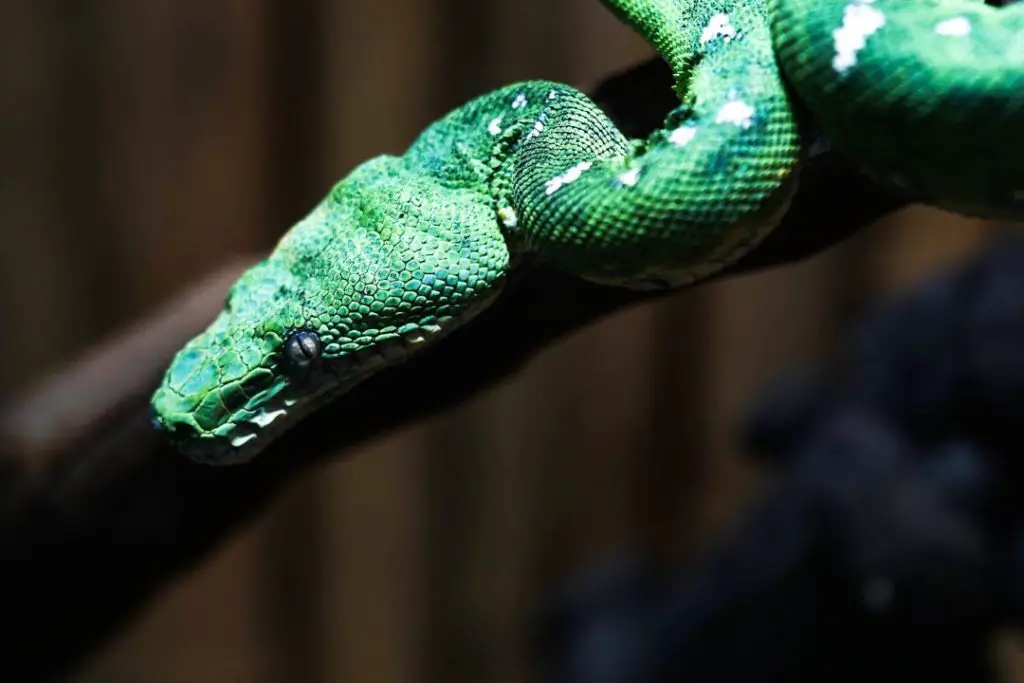
Emerald tree boas usually live in areas where the foliage is so thick that they get very little direct sunlight.
Add on to this that these vibrant snakes use that foliage to hide themselves from prey animals and it becomes even more apparent that they really don’t need UVB lights.
However, there is some evidence that the species does appreciate a UVB bulb and it may lead to better nutritional uptake.
When it comes to it, the choice is yours. Just keep an extra close eye on your humidity levels since UVB lights may extract moisture from the habitat more quickly than other lights.
Additionally, should you choose not to place UVB lighting but would like to give your new enclosure a light, LEDs work wonderfully.
A simple aquarium hood of the correct measurements should be fine. If you have a vivarium, make certain to take your plants into consideration, too.
Shelter and Decorations
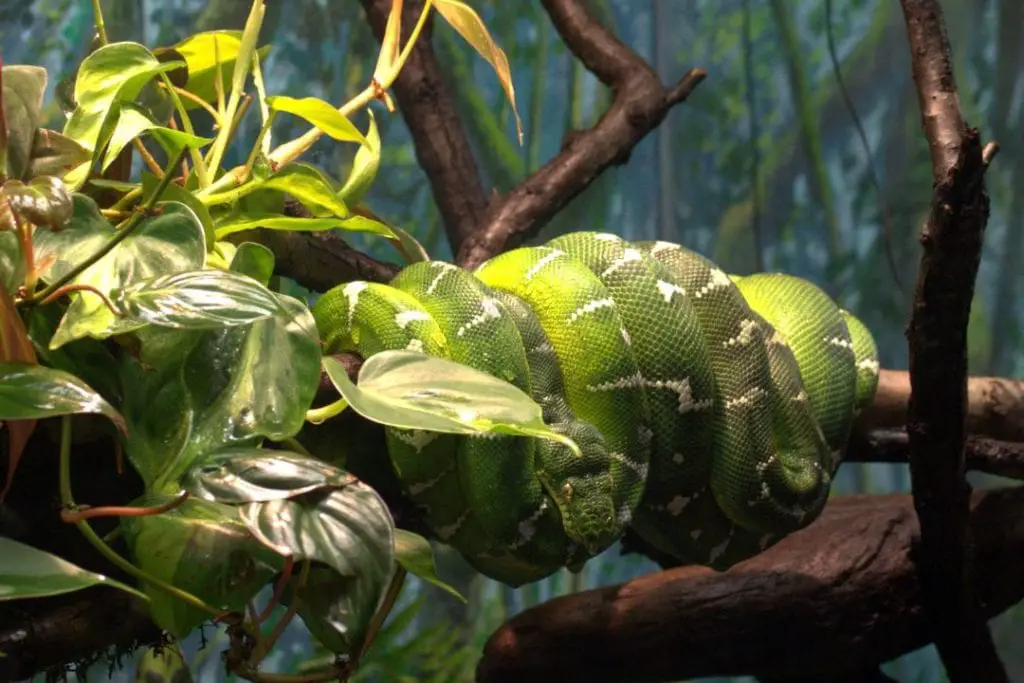
Despite the fact that your emerald tree boa will frequently be out in view and seemingly doesn’t care about showing off to the world, they often desire a place to hide after consuming a large meal or right before they shed.
A hide of appropriate size based on the snake’s length on both the cooler and warmer sides of the enclosure are necessary.
If planting a vivarium, it may be worth it to secure your plants in a way that the snake can enjoy the comforts of shelter while on their perch or tree branches as well.
Ultimately, even if your snake does not frequently use their hides, I guarantee you that they are using them when you are not looking.
These snakes are sometimes predated upon by birds and even humans and do desire a place to hide away from it all.
In fact, if you notice that your snake is getting ready to shed, feel free to upgrade your hides to humid hides with sphagnum moss or cypress mulch to maintain humidity so your snake can peel off in peace.
Looking to DIY your shelter?
Butcher boxes and take-out containers have been used for years now as successful, if not pretty, hides for snakes.
These are especially useful if the snake has a tendency to go into the hide to defecate since they are cheap, readily available, and can be thrown away if the snake makes a mess in there.
If you intend to build a vivarium, you hardly need more than your plants and removable perches for decorations.
However, if you desire something a little more easy to maintain, I recommend searching for cheap, snake-safe fake foliage.
Large stones and odd-shaped branches may be appreciated by your snake simply for variety.
Avoid things such as glitter and sequins on your silk plants as these can easily get lodged under scales or otherwise irritate the snake’s skin on their sensitive prehensile tail.
Water
Clean water bowls with a reptile-safe cleaner. Fresh water must be available at all times and should be placed on the bottom of the enclosure.
Change this water bowl if dirtied or every 2-3 days. We recommend that you place this on the cooler side of the enclosure if you are doing a side-to-side heat gradient.
Required Humidity Levels
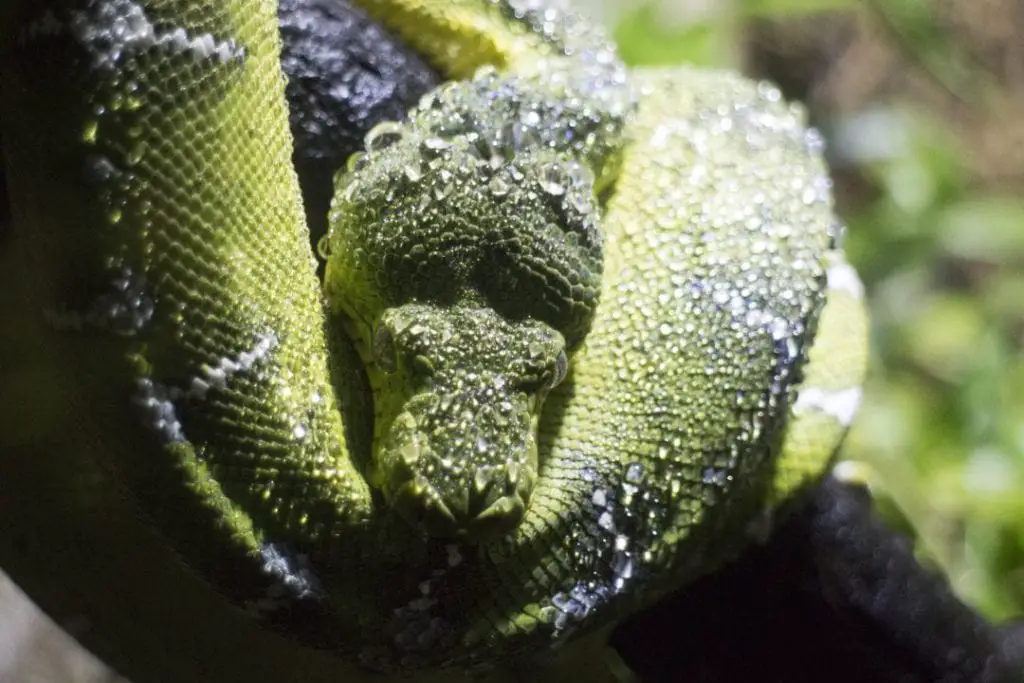
While in quarantine and, perhaps, even if you are using a minimalist concept for your enclosure, we recommend puppy training pads soaked in water and placed at the bottom of the enclosure.
Not only will this maintain a nearly perfect humidity level when kept wet, but it will also be easy to clean and throw away if the snake makes a mess.
Required humidity Levels for Emerald Tree Boas
Humidity ranges for the emerald tree boa are 70 to 80%. This high humidity requirement is one of the hardest parts of owning and successfully keeping an emerald tree boa.
If your snake is failing, it is almost certainly because of too-low humidity.
Place at least three hygrometers in the enclosure with one precisely where your snake is most commonly located.
This will give you a better idea of where you need to spray, how often you need to do it, and how much you need to use.
Should you choose to use an automated sprayer instead of a manual mister, this will still help you adjust to the needs of your snake throughout the year and as they grow.
Keep in mind that typical spraying is not usually enough to reach a suitable humidity range in areas where humidity is lower (or if you are having a drought in your area).
In these cases, many keepers create water features within the snake’s enclosure to help encourage the spread of humidity throughout.
Additionally, you will find that your substrate frequently molds and you may have issues with mildew or peeling silicone due to the intensity of the heat and the humidity.
Keep silicone on hand to fix up failing seams and replace substrate as needed or you will be dealing with a respiratory infection in no time.
Regular Enclosure Maintenance
Your northern emerald tree boa is likely going to be a clean animal and will not require a great deal of maintenance directly related to the snake itself. If you choose to build a planted vivarium, there will be a great deal of upkeep related to that.
When it is time to do a full-box clean out, remove the snake by handling the pole the snake has latched on to. If the snake is on the ground or shedding, just delay your clean out. It’s so much easier than getting bitten.
Once the snake is secured in another location, gently remove your substrate. This does not apply to living vivarium.
Use a reptile-safe cleaner to wipe down walls and the bottom of the enclosure, then replace the substrate as needed.
You can switch up a bit the horizontal branches location for enrichment.
Living vivariums should be complete systems with a poop cleaning crew. If needed, you can wipe down the walls but substrate should be long-term and reliable.
When you have finished resettling the enclosure, replace the snake and its pole, check your thermometer and hygrometer and enjoy your beautiful, clean enclosure.
Feeding
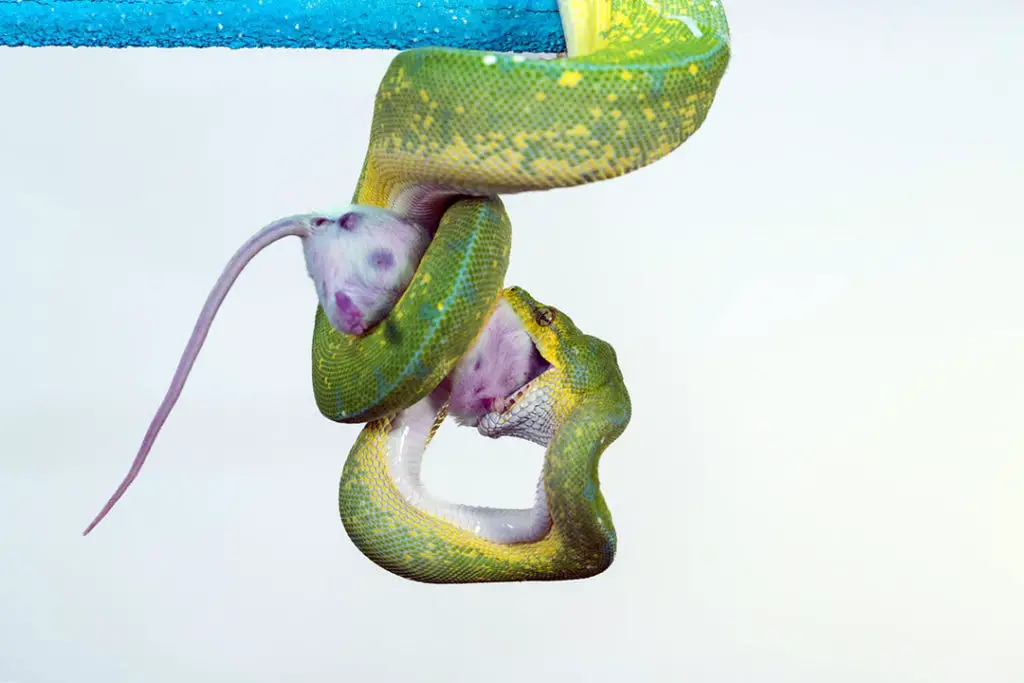
In an ideal world, your snake was started on rats, not mice.
The change from mouse to rat can be unnerving for this sensitive species and, if you intend to breed after experiencing these wonderful snakes for some time, keep this in mind. Start. With. Rats.
Young snakes who are not yet comfortable with frozen/thawed may need to have the prey animal brained, artificially warmed, or scented with a parakeet (who will not be happy about this, I promise) or a pet lizard (again, not going to be pleased).
- Neonates should not be sold, but should you get your hands on them, they must be fed frozen pinkie rat pups.
- Adults should be fed small to medium rats depending on their weight, with mature adult females receiving medium rats at the far end of the scale.
Over all, this species is usually an aggressive eater once you get them going and should not be lacking for interest in predating.
Frozen vs Live
Live should only be used in snakes that refuse all other potential food items.
Do not starve your snake, but do be insistent that the animal consume frozen prey since this is far more easily found than any appropriately-sized live prey animal.
If a young snake misses one meal because they demand live prey, this should not be an issue. If the animal begins to lose significant weight, give in and allow them to have a live prey animal.
This can range from mice to hamsters to gerbils; anything they will take if it is beginning to impact them. Then go back to thawed for the next meal, preferably scenting the prey animal with whatever they ate willingly last time.
Frozen prey’s only con is that you may have to ship in an order to get what you want in large stock. If you have a power outage, this can lead to loss of a fair investment.
Live prey feeding can result in injured snakes, a lack of supply, and a larger chance of zoonotic disease transfer between prey and predator. If your snake will eat frozen, simply give them that.
How Often Do I Feed?
The adult emerald tree boa feeds about once every 2-3 weeks. If your snake looks a little thicker than it should, cut it back to every three weeks.
If your snake appears thinner, it may be one of the ones that requires feeding every two weeks. If you have purchased an adult, you should simply be able to ask for the feeding schedule from the seller.
Younger snakes are something of a crapshoot. Some may need to be fed every week, while others may need to be fed on a schedule closer to adults.
Again, please consult with the person you are purchasing the snake from. If they cannot answer this simple question, you should not purchase the snake at this location.
One last tip: if your snake has not defecated by the end of your third feeding, wait until it goes before you feed again.
This species is well-known for impaction problems and nobody wants to have to work with that veterinary bill.
Shedding
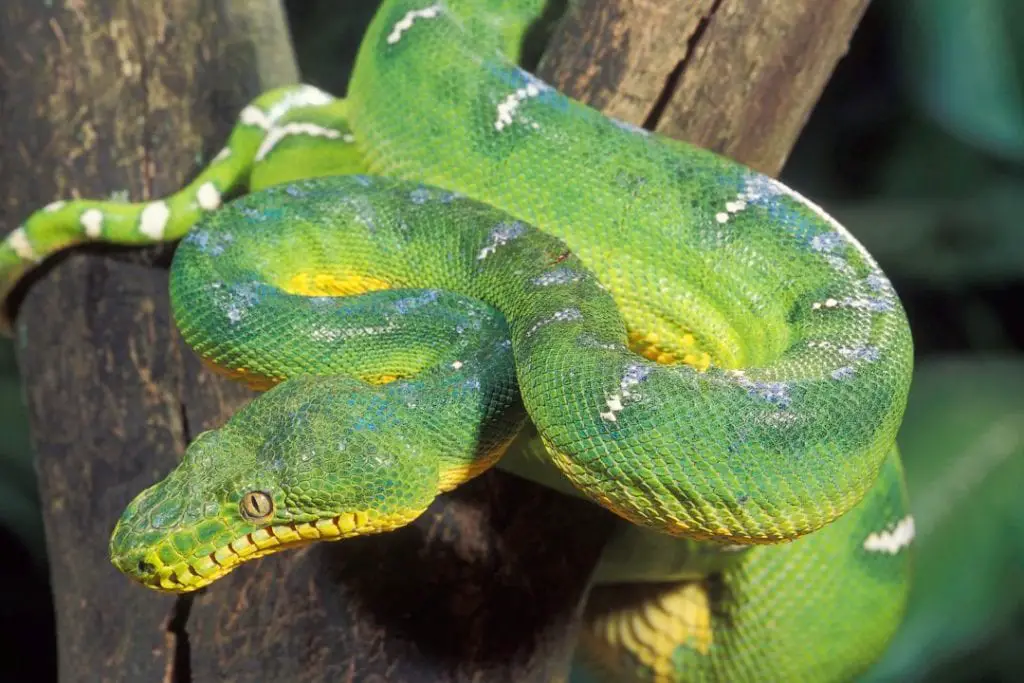
A snake sheds its skin when it grows too large for the old one. In adult emerald tree boas, shedding usually happens once every six months or so.
This will come as no surprise to those used to keeping snakes and most will be familiar with the process. For those who aren’t, we offer this helpful guide.
Do not touch your snake when its eyes appear to be “blue”. This means that the shedding process is getting ready to begin and the snake may have trouble detecting you.
This is already a species that will bite a human, and it tends to be painful thanks to their highly developed front teeth. Do not give it more reason to do so.
If your snake does not shed in one piece, up your humidity. You may offer the snake a bathing bowl as well, so long as the water is kept at the same temperature as the enclosure (or even a little warmer).
If your snake has a disability, you may need to help the snake shed. Have someone control the snake’s head and use a damp q-tip to attach to the tip of the peeling skin and help roll it off the snake.
A veterinarian may be needed in very aggressive or very ill snakes.
Snakes that do not remove their skin from their eyes or vent are in need of medical assistance.
Hibernation (Brumation)
In the wild, most species of snakes take a little time off for when the weather gets chilly.
Though the rainforest doesn’t ever really get what we humans would consider cold, it’s certainly chilled enough that the snakes shut down for their “winter” season.
This can include finding a place to hide for months at a time, not taking in any nutrition or water whatsoever, or they may take in very little water or nutrition compared to the warm months.
If it is winter in your area and the light cycle is leaning toward the darker half of the year, don’t be surprised if your snake suddenly seems disinterested in food.
If possible, use household lights (or the light above the snake) to keep your Corallus Caninus (emerald tree boa scientific name) in their “summer” cycle rather than letting them shut down.
This does tax their system and is one of the things they should not need to deal with in the care of humans.
Handling
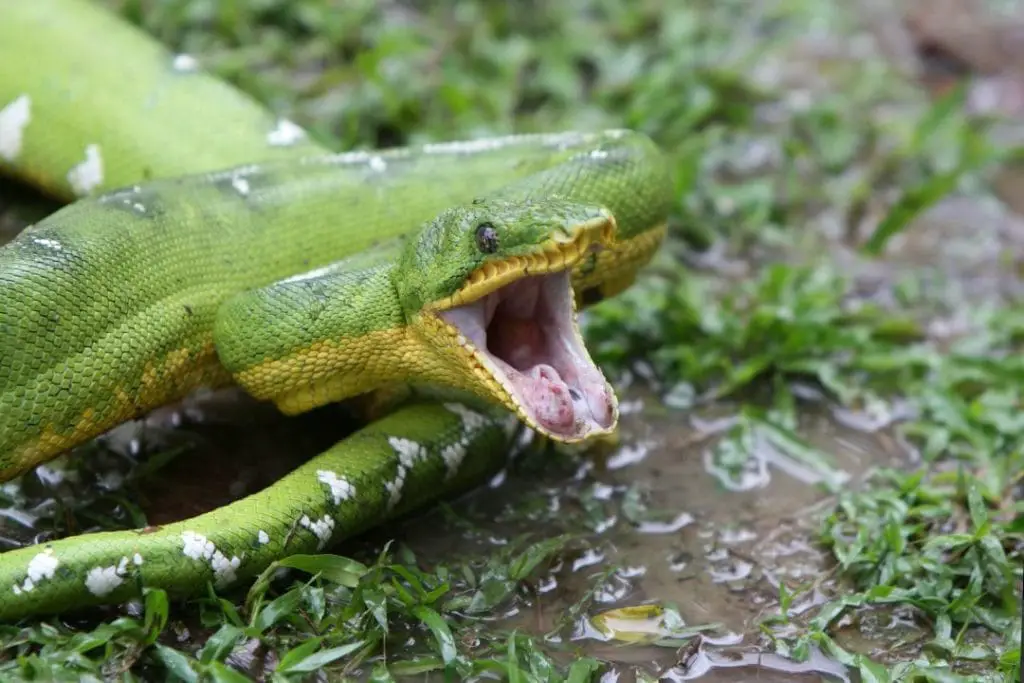
Emerald Tree Boa Bites
If you own an emerald tree boa, chances are that one day that snake is going to mistake your hand for a mouse and bite you.
These aren’t ball pythons and these bites will probably end up with you taking quite some time to heal. If you wrench back from the snake, you may be getting stitches.
I can almost see long-time keepers laughing at this, but we owe it to new keepers to warn them. Additionally: when the snake bites you, don’t pull back. You can seriously injure your snake.
If you must handle an emerald tree boa or a green tree python, try to handle it with a snake hook (gently!) or by moving the entire perch into another enclosure so you can work uninhibited.
This is not a species you’re going to wear around your shoulders to impress your friends (side note: don’t do that with any species, it’s unsafe for you and the snake).
This non venomous snake is a display species. Handle as little as possible and a snake hook comes in handy.
Breeding
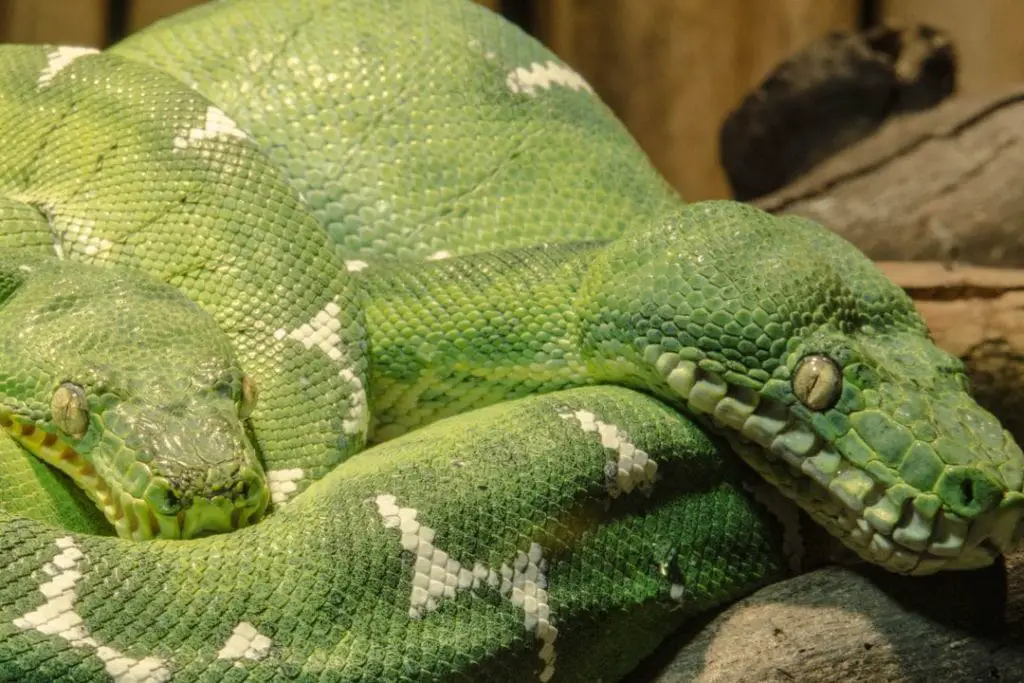
This live-bearing snake is commonly bred for the pet trade and is no longer allowed to be exported from its native country.
Although not a threatened or endangered species, it is a CITES II animal and may require permits for some areas regarding breeding.
Breeding the beautiful emerald tree boa is of moderate attempt. Many zoos have little issue breeding emerald tree boas and experienced keepers often find them easier than garter snakes.
Males are introduced to females, they breed quickly, and males can either be kept with the females while gravid or not. Up to the keeper, though we don’t encourage cohabitation with these snakes.
Once the female gives birth to seven to fifteen young (on average around ten), the nenoates should be removed to their own enclosures immediately.
Common Issues
My emerald tree boa is not eating
This is almost always a humidity issue or simply that the snake is going blue (getting ready to shed) soon. Try again in a week.
My snake has regurgitated
Oh, no. Is this the first time? Feed on a normal schedule and be certain the snake is not too cold when you feed. If this has happened repeatedly, or you see signs of mouth rot contact your vet.
My snake seems to have labored breathing
This could be a respiratory infection, which is not uncommon in the species. This happens for a multitude of reasons and usually needs medication to resolve itself. Again, contact your vet.
Frequently Asked Questions
Conclusion
Interested in learning more about the emerald tree boa?
Drop your questions about these magnificent creatures and comments below! We’d love to hear from you about these wonderful snakes, especially if you’ve kept them before!
Sources
Jacobson, E.R., Heard, D. and Andersen, A., 2004. Identification of Chlamydophila pneumoniae in an emerald tree boa, Corallus caninus. Journal of Veterinary Diagnostic Investigation, 16(2), pp.153-154.
Tepedelen, K., 1989. Captive propagation of the Emerald tree boa Corallus caninus. CAPTIVE PROPAGA'” fION AND HUSBANDRY OF REPTILES AND AMPHIBIANS, 18, p.77.
